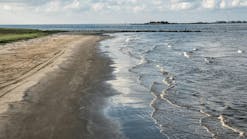EPA protects water quality by regulating municipal separate storm sewer systems (MS4s) to reduce the pollutants that stormwater runoff carries into storm sewers. Nonpoint source pollutants from impervious surfaces such as oil, grease (hydrocarbons), heavy metals from vehicles and atmospheric deposition, fertilizers, pesticides, and sediments are commonly picked up by stormwater runoff and carried through storm sewers. These untreated pollutants can then outfall directly into drainage systems and waterways as point-source discharges. Higher stormwater runoff volumes from impervious areas can also lead to increased channel erosion and sediment loading.
To address the impact of stormwater runoff, MS4s meet permit and total maximum daily load (TMDL) requirements through a suite of strategies, or minimum control measures (MCMs). These include educating and involving the public, identifying and eliminating illicit discharges, controlling soil and erosion sediment-laden runoff from construction sites, and treating runoff from existing impervious areas by implementing post-construction stormwater management (PCSM) or stormwater control measures (SCMs). When a single strategy is not effective, a treatment-train approach, or series of SCMs working together, can do the trick.
Natural Stream Channel Restoration
When combined with other source control treatment measures such as street and inlet cleaning; illicit discharge elimination; and stormwater basins constructed to filter, treat, remove, or reduce pollutants, stream restoration (a recognized structural stormwater best management practice, or BMP) can be used at the end of the treatment train, in combination with other BMPs or SCMs within the contributing drainage area, to dramatically reduce pollutant loads in waterways. When we restore the natural state and functioning of a degraded stream or river, we reduce bed and bank erosion and capture pollutants (sediment and nutrients) within the reconnected flood-prone area and riparian buffer along the restored channel before they are transported downstream.
Natural stream channel restoration is careful business, requiring thorough hydrogeomorphic assessment for natural channel design; wet channel conveyance (regenerative stormwater or step-pool conveyance); legacy sediment removal; flood-prone area (bankfull bench) reconnection; and other streambed and bank modifications to restore stable natural channel forms, functions, and processes. The goal of natural channel restoration is to develop a stable, non-aggrading (depositing), or non-degrading (scouring) channel that exchanges nutrients and retains sediments within the hyporheic (riparian) zone, is connected to its floodplain or flood-prone area, and promotes the establishment of functioning aquatic and terrestrial habitat.
To identify suitable stream restoration locations and approaches and develop an appropriate concept through final design, planners, biologists, environmental scientists, surveyors, and water resources engineers evaluate and complete an inventory of permitting and design-related opportunities and constraints, including:
- determination of prior/historical alteration(s) resulting in current impaired or altered stream conditions;
- verification of accessibility (ownership, easements, and rights of way);
- evaluation of existing adjacent infrastructure (including roads, bridges, sewers, pipelines, public facilities, trails, parks, and greenways) for potential joint development opportunities or avoidance;
- identification of environmental constraints (waste sites and sensitive wetlands, protected species habitat, and historical and archaeological resources) identified for impact avoidance, minimization, or mitigation during the permitting process;
- analysis of stormwater floodplain retention and riparian buffer reconnection opportunities; and
- quantification of existing bed and bank channel erosion, incision, and impairments that, when restored, net the greatest credit for the cost of the proposed restoration.
By carefully assessing and fully evaluating these opportunities and constraints, a cost-effective solution can be developed through advanced planning to address pollutant reduction and removal, stream stability concerns, and potential climate change-related extreme event impacts.
The natural stream channel design and restoration process begins with a detailed fluvial geomorphic assessment and channel survey within the watershed and along the subject reach. An evaluation of existing scoured and unstable channel locations is performed. After identifying the prior or historical channel alterations for the specific reach, existing physical conditions are determined along with the existing channel classification, evolutionary stage of the channel formation process, and the stable channel form. From this assessment and the locations and elevations of bankfull features—identified during the hydromorphic field assessment—detailed design hydrology and hydraulic models are calibrated back to these bankfull features to verify the bankfull discharge.
Using the calibrated base condition model, analyses are then performed to identify the appropriate natural channel stable pattern, profile, and dimension, as well as required sediment transport capabilities. Design data are used in developing the appropriate restorative measures for reconnecting the channel, including design profile and streambank grades; cross-sectional areas for channel and flood-prone/riparian out-of-bank areas; and location of in-channel flow redirection, restoration, and stabilization structures for the restored-stable channel. Design velocities and shear stress values are constantly checked and the design adjusted as needed to verify that the resulting solution will be stable and non-erosive. Where in-channel structures are identified for flow redirection, rock sizing is performed to provide added resiliency under extreme events and for improved sustainability.
Following the design process and development of plans, details, specifications, and cost estimates, the most critical phase of the natural channel restoration occurs: proper interpretation, implementation, and construction. To avoid unanticipated errant interpretation and implementation, designer oversight during construction is outlined within the sequence of construction and required by contract specifications. Rock to be used in developing the restoration structure is approved in the quarry, and other material specified is approved prior to delivery and installation. All installations are performed under the direct oversight of a certified fluvial geomorphologist.
After construction has been completed, channel flow is restored where diversions occur. An adjustment period included in the specifications is then used to monitor the in-channel structure performance. Adjustments are made to in-channel structures, following observation of bankfull and high-flow events. Appropriate riparian seed mixes and soil supplements are applied as specified, and exposed soils are protected with 100% biodegradable erosion control coir matting with the appropriate shear stress rating. Bioengineering-riparian plant materials are placed within and along the restored channel bank and reconnected flood-prone/riparian fringe to reduce long-term maintenance. Stabilization of these areas, using erosion control products with a two-year minimum longevity, is critical to prevent short-term erosion and scour during the period of vegetation establishment. Dense riparian vegetation is necessary for enhanced sediment retention and nutrient uptake.
Stream restoration typically provides the greatest benefit from a sediment pollutant reduction perspective where urban land development is the predominant contributor to the TMDL. Increased impervious cover within the watershed results in increased stormwater runoff volumes, as well as increased and extended peak discharge rates of flow. Channel inverts typically down-cut in these headwater wet and dry channels or experience head-cutting and become incised, entrenched (disconnected from their floodplains), and over-widened (Figure 1) Studies have documented that the majority of the sediment loads within the impaired watersheds are attributable to these unstable in-channel sources. Prior alterations, including encroachment, filling within the flood-prone areas, and channel straightening, are typically the causal factors resulting in impairment and instabilities within these altered headwater channels and floodplains. Where changes to channel pattern and profile are not possible in built environments, natural channel restoration assesses and evaluates the appropriate channel dimensions. Reduction of shear stress within the channel is achieved by excavating the channel bank to reduce the bank slope and by creating a flood-prone area, or bench, at the bankfull height. This bench allows flows greater than the bankfull discharge (the channel forming discharge) to expand into the flood-prone area and reconnected riparian fringe. Excavation of the bankfull bench over point bars located on the inside of the meander bend is most effective during flood-flow conditions. Resulting velocities and shear stress are reduced on the restored channel banks and bankfull bench to a level that can be readily stabilized with bioengineering-vegetative techniques. Figures 2–4 show various stages of the restoration process.
Winning the Cost Versus Benefit Analysis
The cost-benefit analysis for such projects may involve screening multiple sites and studying several concept design alternatives. Stream restoration projects constructed as part of a proper treatment train (and when properly implemented and constructed) will generally maintain themselves while reducing future maintenance costs. Frequently, stream restoration projects can be combined with improvements to public parks and greenways, giving increased weight to the benefit side of the equation. When combined with bridge, water, sewer, pipeline crossings, and other infrastructure improvements within the floodplain, natural channel restoration can be used to effectively treat scour-induced stream and storm flow impacts. By using the natural channel flow (thalweg) redirection process, resulting velocity and shear stress are reduced on streambanks and other in-channel infrastructure (bridge piers, wingwalls, abutments) as a scour countermeasure and preventative maintenance treatment. Multiple benefits result from restoring the riparian ecosystem and aquatic resources and fisheries habitat while protecting the natural infrastructure and stabilizing the existing built infrastructure.
Headwater streams (first-, second-, and third-order streams) that have been filled, drained, channelized, or encroached upon can offer the greatest potential pollutant reduction opportunities through restoration and floodplain/riparian reconnection (Figure 5). Stream restoration for water-quality improvement is most effective when it supports the reconnection of floodplains, reestablishment of native vegetative riparian buffers and floodplain wetlands to promote sedimentation, and nutrient uptake and pollutant removal within the now-functioning storm/floodplain or flood-prone area, thereby reducing in-channel scour and streambank shear stress and erosion.
Impaired stream channels within urban, suburban, or rural agricultural TMDL watersheds that receive or generate pollutant runoff loads can all be treated using the natural stream channel assessment and design process to restore and stabilize channels and improve flood-prone/riparian buffer connectivity while reducing pollutant loads and improving water quality. In the absence of TMDLs, watershed water quality improvement plans (WQIPs) are an alternative approach that can be used to address stream impairments. Like TMDLs, WQIPs work best where multi-municipal watershed coordination occurs, when funding is typically limited. However, a lack of regulatory guidance from which credit for restoration is derived can be an issue. The value added for these multi-municipal partnerships and collaborative efforts can improve opportunities in securing the necessary funding through grants or fees from regulatory violations. Advantages result when multi-municipal consensus is gained and impairments are addressed on a watershed scale. Addressing impairments on a municipality by municipality level can result in transferring or creating additional instabilities in neighboring downstream reaches. Restoring downstream reaches when upstream reaches continue to generate large volumes of sediment due to unstable channel conditions can result in challenges including additional design measures, long-term maintenance to address sediment transport through the restored channel, and removal of excess sediment deposited within the restored reach. To avoid these issues, top-down watershed-stream restoration project implementation is preferred.
In addition to pollutant removal, additional benefits resulting from proactive natural channel restoration can be realized, where existing stream impairments may lead to potential scour undermining and failure of culverts, bridges, roadway embankments, pipelines, and other infrastructure assets during climate change-related extreme events. The Federal Highway Administration and many state departments of transportation are presently in the process of identifying scour-critical, at-risk, and vulnerable infrastructure assets subject to failure during an extreme storm or flood event. MS4s can likewise reduce the risks associated with infrastructure loss during these more frequent extreme events. Planning and prioritization for the implementation of remedial and preventative maintenance measures to improve and provide added resilience for these at-risk, vulnerable assets should be programmed into the municipal maintenance and capital improvement programs.
A thorough scour vulnerability assessment and evaluation of potential risk of failure during an extreme weather event is performed to identify those infrastructure asset locations, where preventative maintenance channel restoration measures should be preemptively performed. The implementation of these natural channel restoring and bank stabilizing measures can assist in avoiding major infrastructure failures or displacements and promote safe, secure, and resilient infrastructure. The realized cost associated with the proverbial “ounce of prevention” is typically many factors less or much cheaper than the “pound of cure” required after an extreme event asset failure.
When properly assessed, designed, jointly implemented, and constructed, natural channel stream restoration can provide the greatest opportunity for pollutant reduction removal at reduced maintenance costs. Benefits typically far exceed cost, when accounting for the triple bottom-line of social, economic, and ecologic benefits. And after trout streams are restored, they fish great and provide fantastic natural infrastructure for passive recreation!
Tom Graupensperger
Tom Graupensperger is a senior environmental scientist, project manager, and NCD restoration designer with Dewberry, a nationwide consulting firm.










